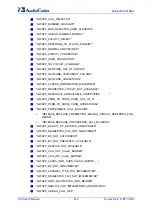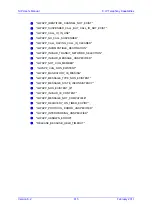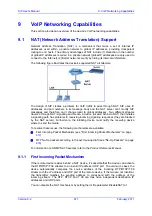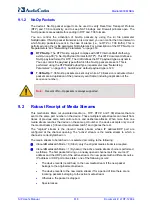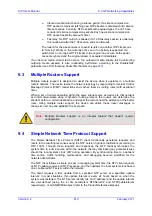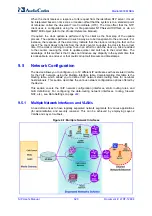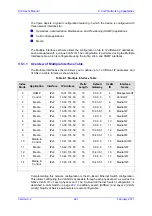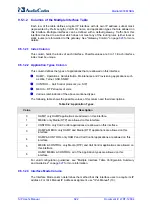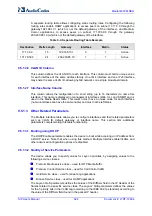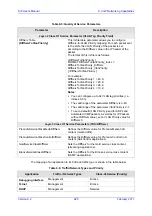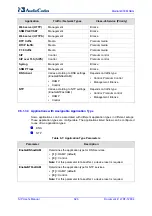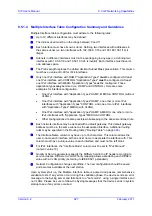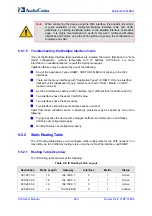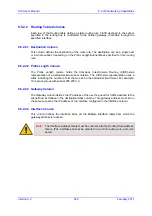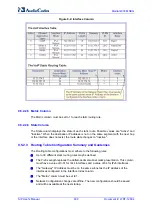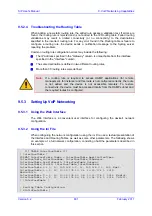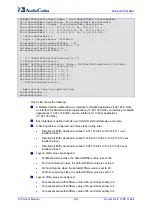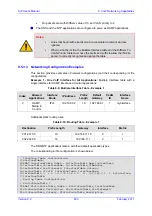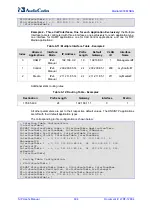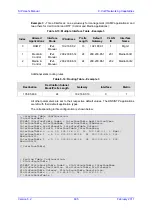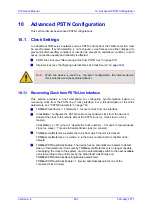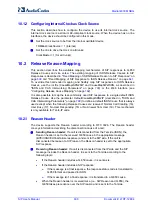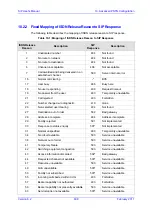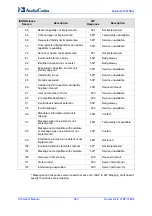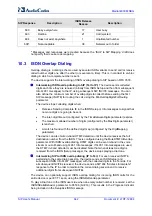
Version 6.2
627
February 2011
SIP User's Manual
9. VoIP Networking Capabilities
9.5.1.4 Multiple Interface Table Configuration Summary and Guidelines
Multiple Interface table configuration must adhere to the following rules:
Up to 12 different interfaces may be defined.
The indices used must be in the range between 0 and 11.
Each interface must have its own subnet. Defining two interfaces with addresses in
the same subnet (i.e. two interfaces with 192.168.0.1/16 and 192.168.100.1/16) is
illegal.
Subnets in different interfaces must not be overlapping in any way (i.e. defining two
interfaces with 10.0.0.1/8 and 10.50.10.1/24 is invalid). Each interface must have its
own address space.
The Prefix Length replaces the dotted decimal Subnet Mask presentation. This column
must have a value of 0-30 for IPv4 interfaces.
Only one IPv4 interface with OAMP "Application Types"
must
be configured. At least
one IPv4 interface with CONTROL "Application Types"
must
be configured. At least
one IPv4 interface with MEDIA "Application Types"
must
be configured. These
application types
may
be mixed (i.e. OAMP and CONTROL). Here are some
examples for interface configuration:
•
One IPv4 interface with "Application Types" OAMP, MEDIA & CONTROL (without
VLANs).
•
One IPv4 interface with "Application Types" OAMP, one other or more IPv4
interfaces with "Application Types" CONTROL, and one or more IPv4 interfaces
with "Application Types" MEDIA (with VLANs).
•
One IPv4 interface with "Application Types" OAMP & MEDIA, one other or more
IPv4 interfaces with "Application Types" MEDIA & CONTROL.
•
Other configurations are also possible while keeping to the above-mentioned rule.
Each network interface may be defined with a default gateway. This default gateway
address must be in the same subnet as the associated interface. Additional routing
rules may be specified in the Routing table (''Routing Table'' on page
).
The Interface Name column may have up to 16 characters. This column allows the
user to name each interface with an easier name to associate the interface with. This
column must have a unique value to each interface and must not be left blank.
For IPv4 interfaces, the "Interface Mode" column must be set to "IPv4 Manual"
(numeric value 10).
Quality of Service parameters specify the DiffServ field in the IP header according to
service classes. DiffServ-to-VLAN Priority mapping allows associating each DiffServ
value with a VLAN priority (according to IEEE 802.1p standard).
Network Configuration changes are offline. The new configuration should be saved
and becomes available at the next startup.
Upon system start up, the Multiple Interface table is parsed and passes comprehensive
validation tests. If any errors occur during this validation phase, the device sends an error
message to the Syslog server and falls back to a "safe mode", using a single interface and
no VLANs. Please be sure to follow the Syslog messages that the device sends in system
startup to see if any errors occurred.
Summary of Contents for Mediant 800 MSBG
Page 2: ......
Page 366: ...SIP User s Manual 366 Document LTRT 12804 Mediant 800 MSBG Reader s Notes ...
Page 372: ...SIP User s Manual 372 Document LTRT 12804 Mediant 800 MSBG Reader s Notes ...
Page 390: ...SIP User s Manual 390 Document LTRT 12804 Mediant 800 MSBG Reader s Notes ...
Page 404: ...SIP User s Manual 404 Document LTRT 12804 Mediant 800 MSBG Reader s Notes ...
Page 616: ...SIP User s Manual 616 Document LTRT 12804 Mediant 800 MSBG Reader s Notes ...
Page 636: ...SIP User s Manual 636 Document LTRT 12804 Mediant 800 MSBG Reader s Notes ...
Page 652: ...SIP User s Manual 652 Document LTRT 12804 Mediant 800 MSBG Reader s Notes ...
Page 886: ...SIP User s Manual 886 Document LTRT 12804 Mediant 800 MSBG Reader s Notes ...


